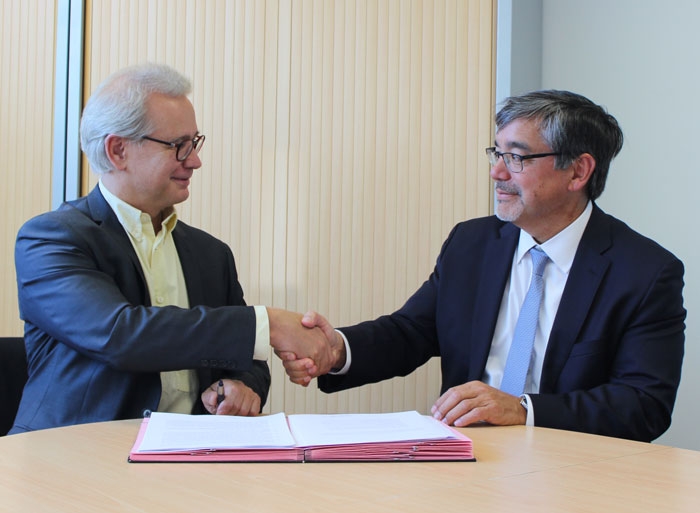The University of Oklahoma and several research universities in France have signed a memorandum of understanding to facilitate cooperation between scientists to advance observations and studies of the atmosphere and radar technologies that will lead to improved weather, climate and air quality forecasts worldwide.
The agreement facilitates collaboration through visiting faculty programs and joint student programs such as summer schools on radar technologies, international exchange programs and supervision for doctoral candidates. It brings together radar and meteorology experts from the University of Oklahoma through its Advanced Radar Research Center (ARRC) and the College of Atmospheric and Geographic Sciences with scientists from the Laboratoire Atmosphères, Observations Spatiales (LATMOS), a French research laboratory of the Université de Versailles Saint-Quentin-en-Yvelines, Université Paris-Saclay, Sorbonne Université, Centre National de la Recherche Scientifique and Institut National des Sciences de l’Univers.
LATMOS specializes in the study of the fundamental physio-chemical processes governing the terrestrial and planetary atmospheres and their interfaces with the surface, the ocean and the interplanetary environment. LATMOS has developed expertise in building innovative instruments deployed from the ground and sometimes put into orbit or set off to encounter other bodies in the solar system.
“To strengthen our collaboration with ARRC through student and exchange programs is a key step to form new scientists and engineers to lead the developments of the next generations of radar dedicated to the observation of our atmosphere,” said LATMOS Director François Ravetta.

The ARRC at OU is the largest academic radar program in the United States and is an innovation leader in radar systems, scientific algorithms and radio frequency components. ARRC Executive Director Robert Palmer said the agreement with LATMOS scientists will “enable a deep collaboration in these areas, and new ones we haven’t even thought of yet, with the most prestigious universities in France.
“It has long been my hope to expand the international experience for our students and faculty, and this agreement paves the way for this goal,” he added.
IMPROVING FORECASTS FROM SPACE
The universities are developing a collective strategy to support the planned NASA Atmosphere Observing System (AOS), expected to launch in 2028, and the deployment of a high-altitude radar for meteorological studies. Both OU and LATMOS are involved in the preparation and design of NASA’s AOS mission.
“The next suite of atmospheric observations from space will target links among aerosols, clouds, atmospheric convection and precipitation to deliver key information for improved forecasts of weather, air quality and climate,” said the Dean of the OU College of Atmospheric and Geographic Sciences and Director of the National Weather Center Berrien Moore. “It will also provide insight into the vertical structure of the atmosphere through complementary observations from space and on the ground. OU has strong expertise on interfacing ground and space observations for the study of aerosols, convection and precipitation from local to continental scales.”
“Interfacing NOAA’s weather radar network and NASA’s global satellite observations of precipitation brought the two agencies closer in terms of science synergy and technology exchange,” said Pierre Kirstetter, associate professor of hydrometeorology in the College of Atmospheric and Geographic Sciences and the Gallogly College of Engineering at OU. “This approach can be applied internationally. We are currently witnessing an integration of suborbital observations to support and supplement orbital science objectives that cannot be achieved by the orbital instruments.”
LATMOS is leading a French contribution to the AOS mission with satellite-based passive sensors. The project, “C2OMODO,” is supported by the French Space Agency CNES. It relies on a tandem of identical sensors forming a “mini-train” to document the rapid evolution of the updrafts within deep convective clouds.
“The synergy with ground-based radar networks such as those led by OU will be a great asset for the documentation of convection and related processes at the global scale,” said Helene Brogniez, the principal investigator of the French C2OMODO project and professor at UVSQ.
THE BENEFITS OF COLLABORATIVE SCIENCE
The establishment of this 2022 agreement builds on a previous agreement signed in 2018 that supported joint scientific publications, supervision of a meteorology graduate student and presentations at international conferences such as the American Geophysical Union, the American Meteorological Society and the European Geophysical Union.
“LATMOS has developed a great deal of expertise in remote-sensing techniques from the ground to space,” said Philippe Keckhut, vice-president of UVSQ for research and innovation. “Microwaves have made it possible to study the water cycle, clouds and atmospherically dynamic parameters. These developments have also been the subject of valorization and transfer of technology, which have given rise to commercial applications.”
“The applications are numerous and critical for studying meteorological and climatic processes,” he added. “In order to predict the instruments required tomorrow for science and monitoring issues which may be on board balloons, airplanes or in orbit around the Earth, the UVSQ needs to work with one of the most experienced laboratories currently in radar technologies applied to the water cycle like the ARRC at the University of Oklahoma. The complementarity will allow us to create a unique consortium on this domain.”
Moore noted that this 2022 agreement also builds upon a close partnership around the NASA GeoCarb Mission between OU and the Laboratoire des Sciences du Climat et de l’Environnement at Université de Versailles Saint-Quentin-en-Yvelines.
The partnering institutions are also planning an international four-week scientist retreat scheduled to begin in June 2022. The workshop will gather a select group of leading scientists on the atmospheric cycle with expertise on observations and models ranging from local to global scales to create conditions for breakthroughs in the atmospheric sciences and the water cycle. More information is available via the Institut Pascal, Universite Paris-Saclay.

